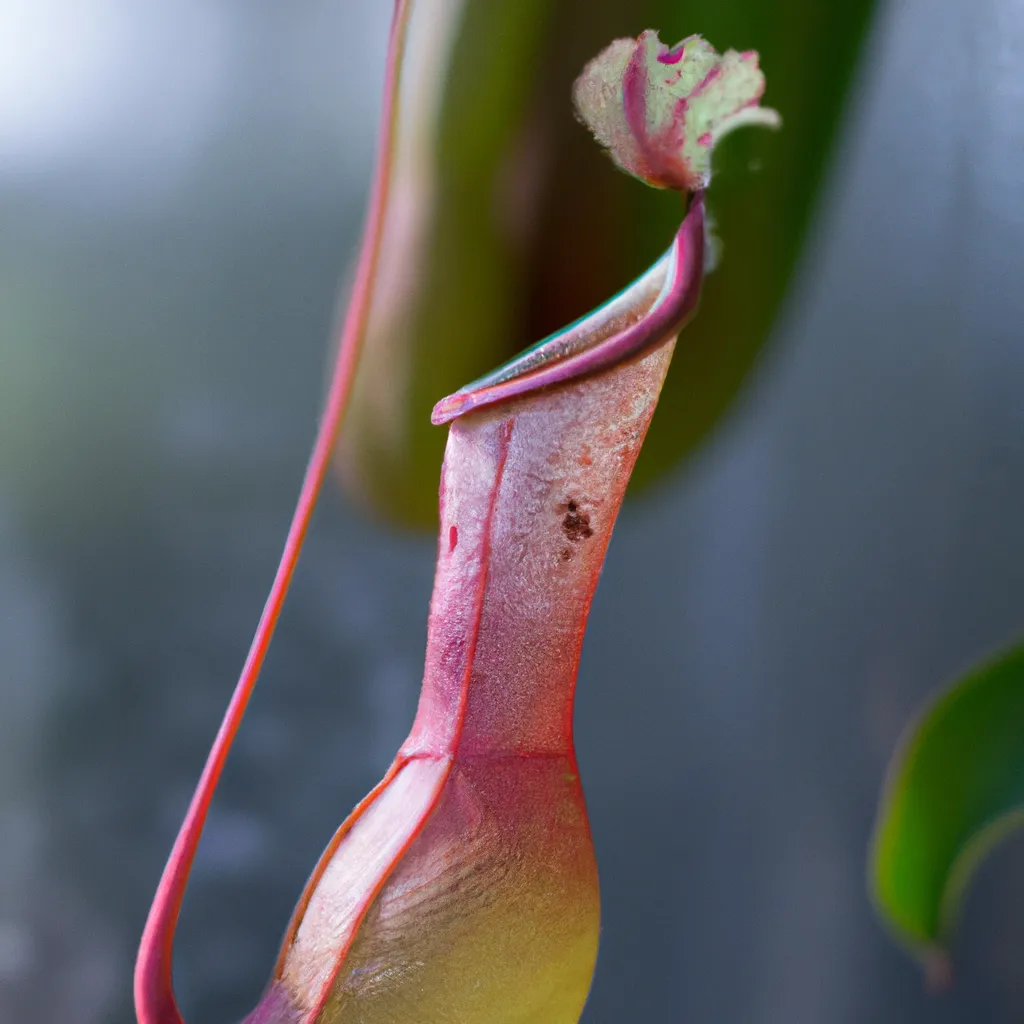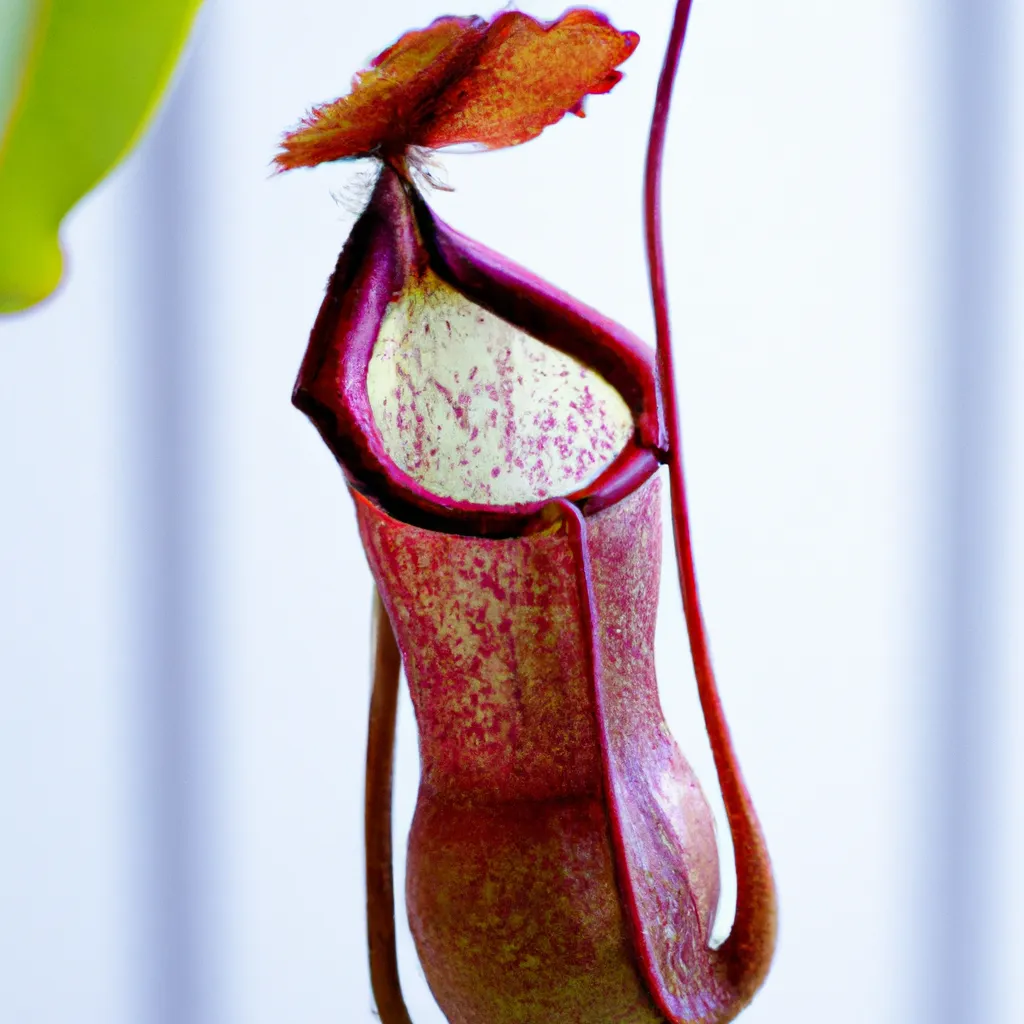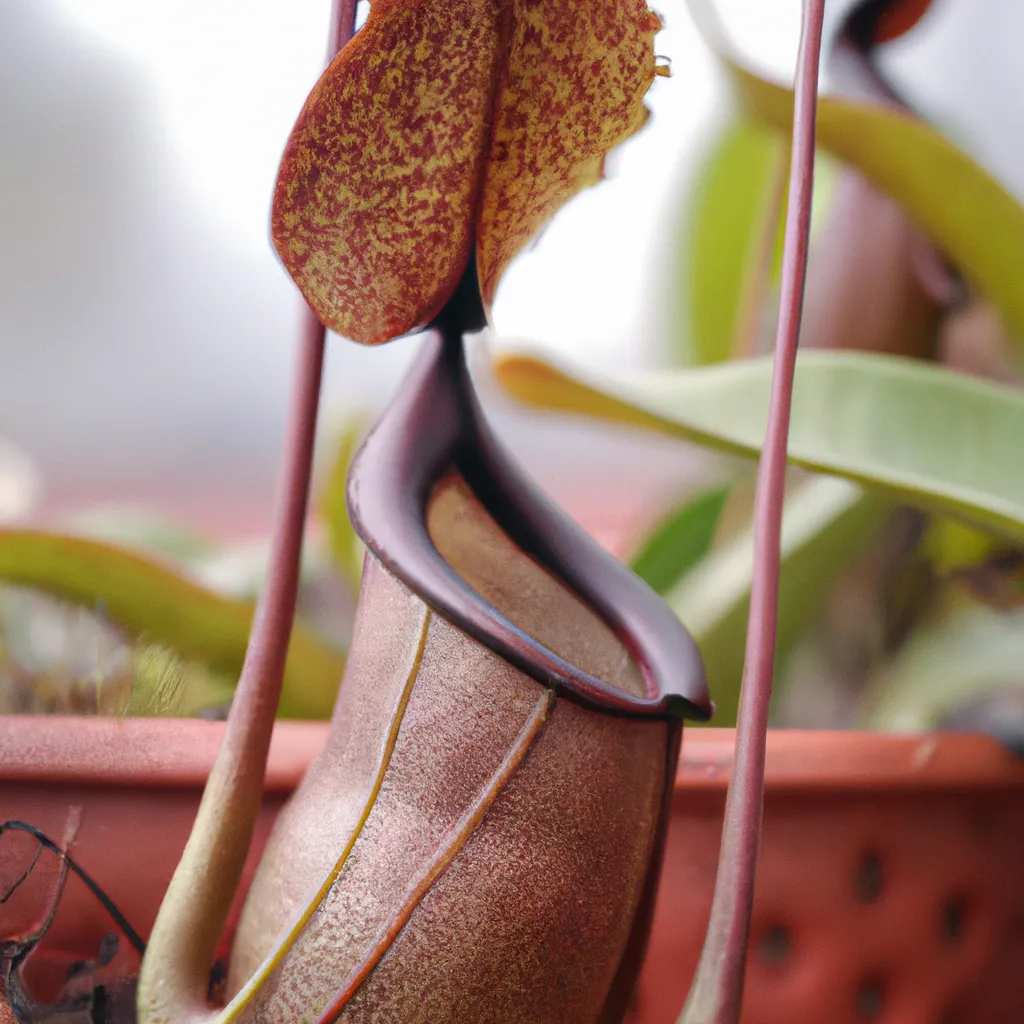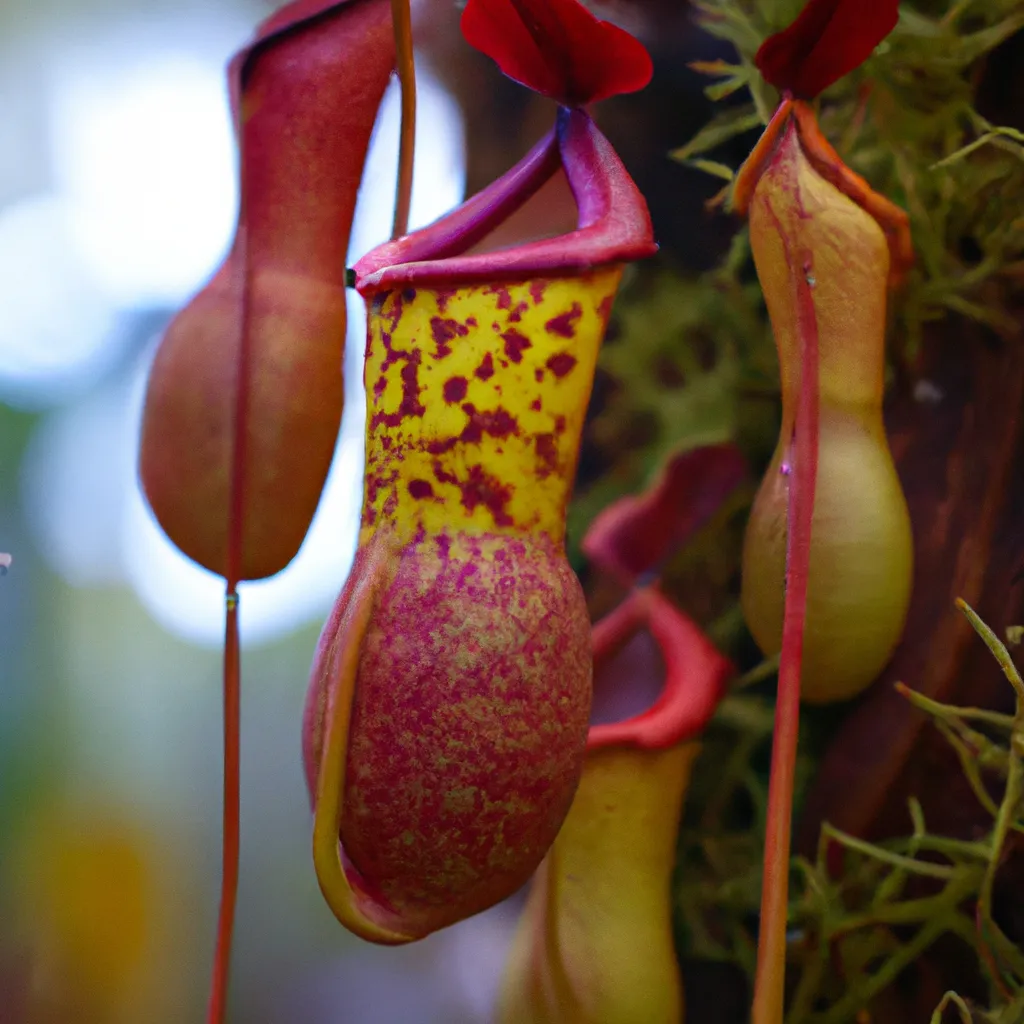Table of contents
你听说过Nepenthes Bicalcarata吗? 这种植物简直令人着迷!它是一种食肉植物,为了生存而吸引、捕捉和消化昆虫。 没错,它是飞行生物的死亡陷阱!如果你认为这种植物不那么有趣,我将告诉你更多关于它的信息,我相信你会对它感到惊讶。这个植物能做什么,我们可以吗?

发现迷人的Nepenthes Bicalcarata:昆虫的死亡陷阱!"摘要
- 牛膝草是一种以昆虫为食的多肉植物。
- 它被发现在亚洲的潮湿和沼泽地区,如婆罗洲和苏门答腊岛。
- 它的名字来自于陷阱顶部突出的两根刺,像一对角。
- 昆虫被植物产生的花蜜的颜色和气味所吸引。
- 当昆虫落入陷阱时,它会滑向底部,在那里它被困于一种粘性物质。
- 然后植物释放消化酶,分解昆虫并吸收其营养。
- 与其他食肉植物相比,Nepenthes Bicalcarata能够捕获更大的猎物,如蜥蜴和啮齿动物。
- 除了它的食物功能,该植物还因其异国情调和独特的美丽而受到重视。

介绍Nepenthes Bicalcarata:世界上最神秘的多肉植物!
你听说过Nepenthes Bicalcarata吗? 这是世界上最迷人的多肉植物之一!它以致命的昆虫陷阱和异国情调的美丽而闻名。 在这篇文章中,我们将探讨你需要了解的关于这种神秘植物的一切。
深入了解牛膝陷阱是如何工作的?
Nepenthes Bicalcarata有一个壶状的陷阱,里面装满了消化液。 昆虫被植物的颜色和香气吸引到壶内。 当它们进入壶内时,被毛发困住,无法逃脱。 然后消化液溶解了昆虫的组织,将它们转化为植物的营养。
哪里可以找到Nepenthes Bicalcarata? 自然栖息地和环境保护。
Nepenthes Bicalcarata原产于位于亚洲的婆罗洲。 它生长在雨林的潮湿沼泽地带。 不幸的是,该植物的自然栖息地被破坏,导致其在某些地区灭绝。 保护这些自然栖息地以确保Nepenthes Bicalcarata的生存非常重要。
哪些昆虫会被牛膝吸引? 对其食物的好奇心。
Nepenthes Bicalcarata被各种昆虫吸引,包括苍蝇、蚂蚁和甲虫。 它甚至能够消化较大的昆虫,如毛虫和蜘蛛。 有趣的是,这种植物还能够适应其猎物。 在昆虫较少的地区,它可以生产较小的陷阱来捕捉昆虫。
肾上腺素的药用特性:神话与真相。
围绕着牛膝的药用价值有很多神话。 有些人认为它可以用来治疗哮喘和肺结核等疾病。 然而,没有科学证据证明这些好处。 不过,在一些文化中,这种植物还是被认为是传统医学的宝库。
护理牛肝菌:家庭或花园的种植技巧。
如果你想在家里或花园里种植牛膝草,有几件事你需要知道。 它需要一个潮湿和温暖的环境才能正常生长。 此外,它需要间接的阳光和蒸馏水或过滤水。 确保你不要给它喂食活的昆虫,因为这会损坏陷阱。
结论:爱上美丽而神秘的牛膝草!
尼泊尔是一种集美丽和神秘于一身的迷人植物。 它对昆虫的死亡陷阱和对猎物的适应性只是使它如此特别的一些东西。 如果你正在寻找一种异国植物加入你的花园或收藏,尼泊尔是一个很好的选择!

| 命名 | 地点 | 特点 |
|---|---|---|
| 尼泊尔 | 亚洲 | 这种植物是Nepenthes的一个品种,以在陷阱的顶部有两根尖锐的刺而闻名,作为防止小动物逃跑的屏障。 这种植物能够长到30厘米高,其叶子可以达到20厘米长。 |
| 昆虫诱捕器 | 在热带雨林中 | Nepenthes bicalcarata是一种食肉植物,利用其陷阱来吸引、捕捉和消化昆虫。 陷阱由一个漏斗状的罐子组成,顶部有一个开口,底部装满消化液。 昆虫被陷阱顶部产生的花蜜吸引,最后落入液体中,被植物消化掉。 |
| 改编 | 为了在营养贫乏的土壤中生存 | 剑麻是一种生长在营养贫乏的土壤中的植物,所以它已经发展出捕捉昆虫的能力,以获得生存所需的营养。 此外,这种植物能够适应不同的气候条件,在印度尼西亚、马来西亚和菲律宾等国家的热带雨林中都可以找到。 |
| 奇闻趣事 | 有超过170种的Nepenthes | Nepenthes bicalcarata只是世界上存在的170多种Nepenthes中的一种。 这些植物被认为是真正的自然艺术品,受到植物收藏家的高度重视。 此外,一些Nepenthes物种被用于传统医学,以治疗哮喘和肺结核等疾病。 |
| 来源 | //en.wikipedia.org/wiki/Nepenthes_bicalcarata | 关于Nepenthes bicalcarata的更多信息,请进入链接。 |

1. 什么是Nepenthes bicalcarata?
Nepenthes bicalcarata是Nepenthaceae家族中的一种多肉植物,原产于婆罗洲岛。
2.Nepenthes bicalcarata是什么样子的?
Nepenthes bicalcarata的叶子呈壶状,长度可达30厘米。 这些壶的特点是在上部有两个刺状突起。
See_also: 紫色花朵:名称、类型、种类、列表、图片3. Nepenthes bicalcarata如何吸引其猎物?
Nepenthes bicalcarata通过分泌在投石器边缘的甜美花蜜来吸引猎物。 猎物被花蜜吸引,最后落入投石器,在那里被植物内部的消化液消化。
4.Nepenthes bicalcarata的自然栖息地是什么?
Nepenthes bicalcarata主要存在于婆罗洲岛的热带雨林中,它生长在营养不良的土壤中。
尼泊尔:一个捕虫器!5.Nepenthes bicalcarata是如何繁殖的?
凤仙花通过种子繁殖,种子由风或以其果实为食的动物散播。
6.Nepenthes bicalcarata对生态系统的重要性是什么?
Nepenthes bicalcarata对生态系统很重要,因为它是一种肉食性植物,有助于控制其自然栖息地的昆虫和其他小动物的数量。
尼泊金是如何适应营养不良的土壤的?
牛膝草通过捕捉猎物来适应营养不良的土壤,猎物为它的生长和发育提供了必要的营养物质。
8.Nepenthes bicalcarata在分类学上是如何分类的?
在分类学上,Nepenthes bicalcarata被归入Nepenthaceae科、Caryophyllales目、Magnoliopsida类和Plantae王国的一部分。
9.食肉植物是如何进化的?
食肉植物的进化是为了适应营养贫乏的土壤,在那里捕获猎物成为其发展的重要营养来源。
10.Nepenthes bicalcarata与其他种类的食肉植物有什么不同?
❤️eus的朋友们正在享受它:
